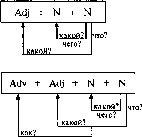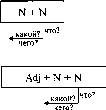В. Н. Бгашев е. Ю. Долматовская английский язык для студентов машиностроительных специальностей учебник
 Скачать 1.36 Mb. Скачать 1.36 Mb.
|
|
б) Найдите предложения с данными словами в тексте и проверьте по контексту правильность выбранных вами значений. Выпишите из третьего и предпоследнего абзацев английские слова и сочетания слов, служащие для обозначения понятий, связанных с деятельностью инженера в конструкторском бюро. Переведите их на русский язык с помощью политехнического словаря и дополните таблицу.
Выпишите из второго абзаца текста английские слова и сочетания слов, служащие для обозначения понятий, связанных с деятельностью инженера в лаборатории. Переведите их на русский язык с помощью политехнического словаря и составьте таблицу, аналогичную таблице задания 2. Найдите в четвертом — седьмом абзацах текста цепочки слов, построенные по моделям 1 — 4, и переведите их на русский язык.   < какой?I 1) 2) 4) 3) Примечание: Adv — наречие на -1у. Переведите цепочки на русский язык. Найдите в четвертом—восьмом абзацах текста английские эквиваленты для следующих русских слов и словосочетаний. существующий процесс, источники энергии, установка, узлы, сплавы, транспортировка, упорно работать, инженерное умение, ответственный за..., в своем распоряжении GRAMMAR REVISION Категория вида (The Category of Aspect)
Примечания'. I. В формах Continuous вспомогательный глагол to be несет все показатели лица, числа, времени, залога в предложении, согласуясь с подлежащим. В вопросительной форме он выносится в позицию перед подлежащим; в отрицательной форме соединяется с частицей not: Не is working at this plant now. Is he working at this plant now? No, he is not. He is not working at this plant now. Формальные показатели длительности совместно с показателями времени помогают правильно выбрать форму глагола. Найдите в первом абзаце текста предложение с глаголом длительного вида и переведите его на русский язык. Прочитайте следующие предложения, переспросите о происходящем действии и дайте отрицательный ответ. Model: This engineer is working in the field of automaking. Is this engineer working in the field of automaking? No, he is not working in the field of automaking. am making a diagram now. 2. He is preparing for his report at the conference now. 3. He was doing an interesting work last week. 4. She will be working at our laboratory next year. 5. Wfe are studying new drawings and specifications at present. 6. They were working on a new type of body fixtures last month. Сравните следующие предложения, переведите их на русский язык. 1. Our engineers work hard at this problem. Look at these two men — they are working at a new problem. 2. Our autoplants produce all the main body components. This plant is producing only tyres now. 3. “Moskvitch 2141” has the speed about 150 kilometres per hour. Look at this car. I think it is doing 160 kilometres per hour now. 4. They designed this instrument for laboratory research last year. When we visited their institute they were designing the new equipment. Прочитайте текст и переведите его, обращая внимание на многообразие функций глагола to be. Mr White is a transport planner. Among other things his work is to develop future transport systems. This is a very difficult task, because there is too little scientific information on this subject. He is to find answers to such questions as: Why are some people fond of cars while others are inclined to walk? What are the reasons for some people using aeroplanes? Are people going to use bicycles instead of cars? Questions like these are not easy to answer. Переведите на русский язык. The millionth electric motor is rolling off the conveyer line of the plant now. Representatives of more than 80 professions took part in its manufacture. Next year the plant will be producing 1000 electric motors every day. Ответьте на данные высказывания, употребив длительный вид и наречие still. Model: — I know he was working on his report about new kinds of engines last week. He is still working on it. know she was teaching chemistry last year. 2.1 know he was working at your laboratory last month. 3.1 know you were working a lot last year. I know this plant was trying to expand the production of new tools. 5. I know he was preparing for a difficult experiment last week. 6. I know this scientist was developing a new theory last year. Используйте следующие предложения для описания современного состояния науки. Model: — The volume of scientific information did not grow so rapidly in the 19th century. The volume of scientific information is growing very rapidly now. 1. Knowledge did not expand so rapidly in the 19th century. 2. Not so many people took part in research in the 19th century. 3.Scientists did not work in big research teams in the 19th century. 4. Not so many new branches of science appeared in the 19th century. 5. Research centres did not grow so rapidly in the 19th century. 6. Scientific thinking did not develop so rapidly in the 19th century. 7. Scientists did not publish so many papers in the 19th century. Покритикуйте следующие заявления, употребив not... enough. Model: — The situation is improving. Quite true, but it is not improving rapidly enough. 1. We are using this technique effectively. 2. Scientific contacts are expanding. 3. He is doing this work well. 4. Research methods are improving. 5. This process is going rapidly. 6. Technology is developing. 7. Our knowledge of the world is growing. Раскройте скобки и поставьте глагол в нужную форму времени и вида. 1. I know she (to prepare) for a difficult experiment now. 2. What you (to do) when I came in? — I (to read) an article on the British educational system. 3. I thought you (to do) this work yesterday. — Yes, and I still (to do) it. 4. Tomorrow at 6 o’clock I (to report) the results of this analysis. 5. Our laboratory will be provided with new equipment. These two engineers (to mount) a new electronic system. | ||||||||||||||||||||
